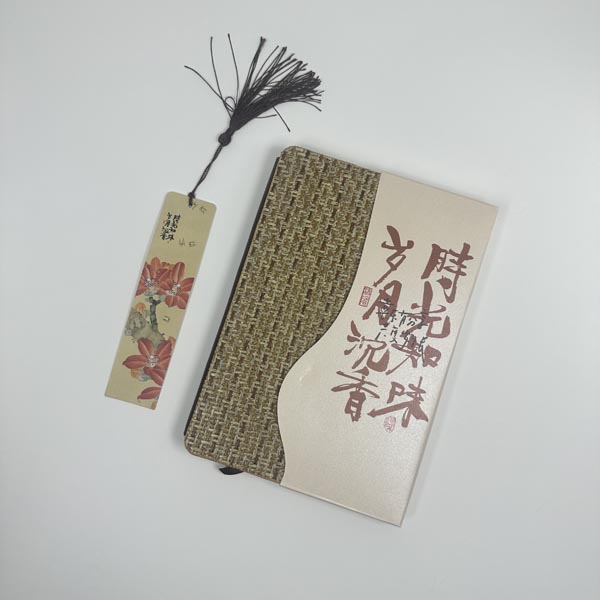How does the color of straw affect the appearance of the notebook?
2024-11-14

How is the notebook produced using straw?
The process of producing a notebook using straw involves harvesting straw and weaving it together with ropes, which then forms the base of the notebook. It is then dyed with various colors, which affects the final appearance of the notebook. The size and shape of the notebook are customized according to requirements. The notebook is then bound together using staples or threads, which give the notebook its final form.
What are the benefits of using straw in notebook production?
Using straw in notebook production has various advantages, including being eco-friendly and sustainable. The use of natural fibers reduces the use of chemicals, which is typically used in paper production. It also promotes traditional methods of production, which supports local artisans and farmers. In addition, it gives a unique texture and color to the final product.
How does the color of straw affect the appearance of the notebook?
The color of the straw significantly impacts the final appearance of the notebook. The colors used in dyeing the straw range from pastel shades to bright colors, giving a unique appearance to the notebook. Customers can choose colors that align with their personality or choose notebooks that are suitable for gifting purposes.
In conclusion, the use of straw in notebook production is a perfect blend of creativity and sustainability. It supports local artisans and farmers and promotes a natural way of production that is eco-friendly. The unique texture and color of the notebook give it an edge over traditional notebooks. It is perfect for customers looking for something different that aligns with their values.
Suzhou Aiyide Stationery Co.,Ltd. is the parent company of the Straw plaited article notebook factory. It is a renowned brand that produces sustainable stationery products. They believe in providing customers with high-quality products that align with their values. To know more about their products, visit their website at www.aiyidesz.com. For any queries, please contact them at sale@aiyidesz.com
Research Papers:
1. N. C. Cheng, H. C. Cheng, “Comparative Study on the Properties of Paper Bleached by Various Oxidizers,” J. Chin. Inst. Chem. Eng. (Taipei), Vol. 16, pp. 321–329 (1985).
2. J. Cunha-Pereira, F. Durães, E. Ferreira, R. M. Guedes, A. Rasteiro, “Recycling of Tetrapak Packages: A Review,” Waste Manage., Vol. 29, pp. 2931–2945 (2009).
3. G. Y. Onoda, Y. Shirai, A. Tsujimoto, K. Aoi, “Assessment of Environmental Efficiency of Various Treatment Technologies for Used Paper: Comparative Life Cycle Assessment and Data Envelopment Analysis,” Water Res., Vol. 41, pp. 4385–4391 (2007).
4. A. P. Gonçalves, C. G. Silva, M. Bilbao-Sainz, R. A. Williams, R. A. P. M. Castilho, “Lactic Acid Production from Waste Cardboard and Straw Pulp: Process Development, Modeling, and Life Cycle Assessment,” Bioresour. Technol., Vol. 102, pp. 1230–1238 (2011).
5. S. G. de Castro, J. M. M. Araújo, C. Ferraz, “Production of Ethanol from Straw, Using Kluyveromyces marxianus UFV-3: Parameter Optimization Using Statistical Design of Experiments,” Bioresour. Technol., Vol. 99, pp. 937–944 (2008).
6. R. D. Marechal, H. L. Teixeira, C. A. Costa, L. S. Gazel, “Influence of the Volume ratio of H2O2: Organic Liquor on the Chemical and Physical Properties of Pulp Obtained by the Peroxide Process,” J. Wood Chem. Technol., Vol. 14, pp. 181–202 (1994).
7. Y. Saurabh, A. K. Gupta, “Variation in Wood Density and Chemical Composition of Trees with Age, Sex, and Location: Implications for Electrical and Mechanical Properties,” Eur. J. Wood Prod., Vol. 78, pp. 269–278 (2015).
8. J. M. C. Molina, B. S. M. Montanez, S. A. Brown, “Tissue-Scale Preferential Localization of YeosgDNA4-Linked Protease Consumption Sites in the Developing Mouse Ovary,” Reprod. Fertil. Dev., Vol. 23, pp. 593–603 (2011).
9. A. Anterola, S. A. Lewis, D. A. Chapin, S. Marek, J. C. Mrotek, K. D. Elmer, “Enhanced Lignin Monomer Production in Flax (Linum usitatissimum L.) Using Constitutively Truncated 4-Coumarate:CoA Ligase,” Plant Biotechnol. J., Vol. 7, pp. 694–703 (2009).
10. J. Bao, K. T. Klasson, Y. Lu, R. J. Biehl, G. T. Tai, L. J. Rezac, “Thermal Pretreatment of Municipal Solid Waste and Dairy Manure for Improving Biochemical Methane Potential,” J. Air Waste Manage. Assoc., Vol. 63, pp. 68–76 (2013).
 English
English Español
Español Português
Português русский
русский Français
Français 日本語
日本語 Deutsch
Deutsch tiếng Việt
tiếng Việt Italiano
Italiano Nederlands
Nederlands ภาษาไทย
ภาษาไทย Polski
Polski 한국어
한국어 Svenska
Svenska magyar
magyar Malay
Malay বাংলা ভাষার
বাংলা ভাষার Dansk
Dansk Suomi
Suomi हिन्दी
हिन्दी العربية
العربية




